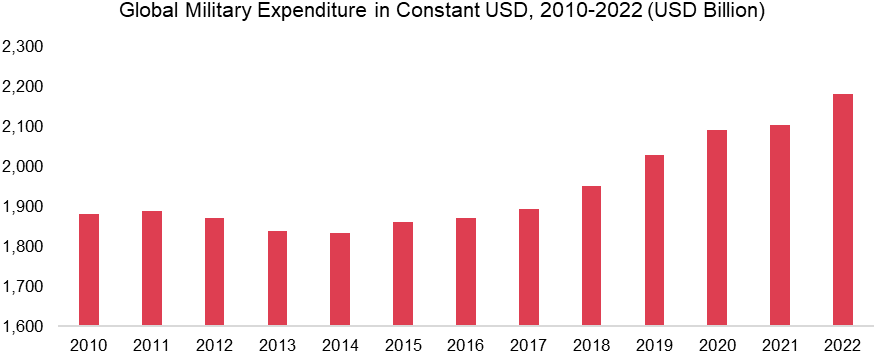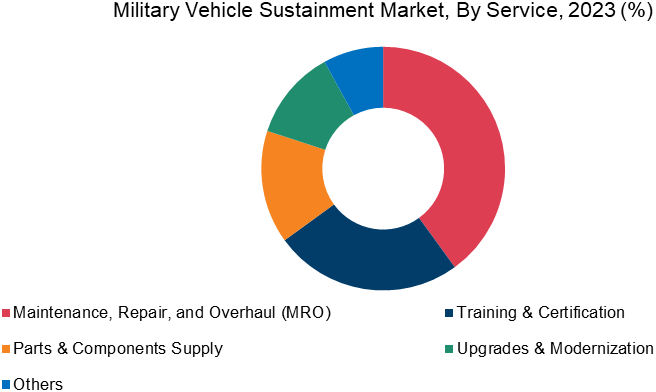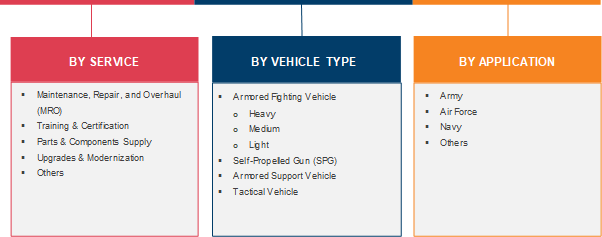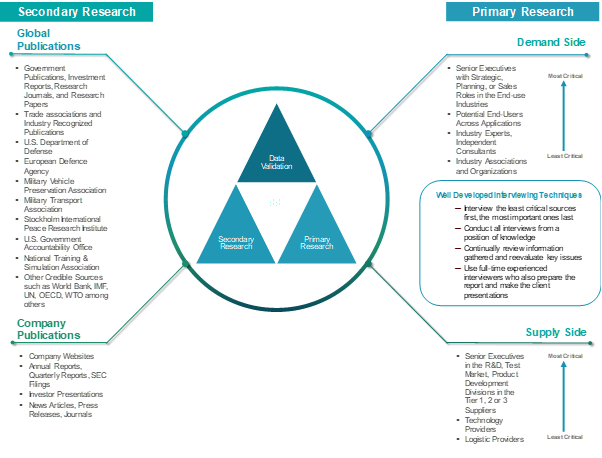According to Intent Market Research, the Military Vehicle Sustainment Market is expected to grow from USD 14.3 billion in 2023-e at a CAGR of 7.8% to touch USD 24.7 billion by 2030. The military vehicle sustainment market is competitive, the prominent players in the global market include BAE Systems, Cummins, Elbit Systems, Kratos Defense & Security Solutions, Oshkosh, Rheinmetall, SAIC, Siemens, Thomas Global Systems, and VSE.
The Military Vehicle Sustainment Market was valued at USD 14.3 billion in 2023-e and will surpass USD 24.7 billion by 2030; growing at a CAGR of 7.8% during 2024-2030.

An increasing adoption of software as a service (SaaS) and data analytics, coupled with a growing need for efficient sustainment service providers, is driving market growth. Technological advances in additive manufacturing and the increasing adoption of autonomous systems are anticipated to provide significant growth opportunities for the military vehicle sustainment market. In addition, rising military expenditure is also augmenting the growth of the market.
Military Vehicle Sustainment Market Overview
Military vehicle sustainment is the provision of support and services required to maintain and prolong the lifecycle of the military vehicles active in the fleet. Military vehicle sustainment is one of the major operational & support expenditures in the defense budget that has been growing at a significant pace. This can be attributed to the increasing military spending and growing military vehicle acquisitions across the globe.
The sustainment of military vehicles is one of the core functions of mission readiness. A range of factors that impact mission readiness include aging military vehicles, unscheduled maintenance, unanticipated part replacements and repairs, supply deficiencies, trained personnel shortages, diminishing manufacturing sources, and parts obsolescence. Military vehicle sustainment services can help in tackling all these factors thereby driving the demand for military vehicle sustainment services.
Rising Military Expenditure is Augmenting the Market Growth
According to the Stockholm International Peace Research Institute (SIPRI), the total global military expenditure increased by 3.7% in 2022, accounting for USD 2,240 billion. The ongoing Russia-Ukraine war and rising geopolitical tensions in the Middle East and East Asia are some of the leading drivers for the increased military spending in recent years. According to the SIPRI report, the military expenditure in Europe has experienced the steepest year-on-year increase in last 30 years.
There has been a significant rise in the acquisition of military vehicles in key countries in Europe. For instance, in April 2023, Germany signed a contract with BAE Systems amounting to USD 400 million to secure 227 all-terrain armored vehicles from BAE. This highlights the impact of increasing global military expenditure on propelling the military vehicle sustainment market.

Source: SIPRI
Digitalization of Maintenance, Repair, and Overhaul (MRO) Services is Driving the Segment Growth
The MRO services is primarily involved in the maintenance and repairs of military vehicle fleets. The demand for MRO services is increasingly rising with the expansion of military vehicle fleets and increasing lifecycle extension needs of existing military vehicles. Moreover, the increasing adoption of digital MRO solutions to manage military vehicles to improve fleet availability, reduce MRO costs, and optimize fleet safety and sustainability will drive the segment growth.
The key companies are actively developing robust digital MRO solutions to enhance their product portfolio. For instance, in October 2023, Curtiss-Wright obtained a contract from General Dynamics Land Systems (GDLS) to provide MOSA (Modular Open Systems Approach) compliant technology for the managed switch field upgrade program of the Stryker ground combat vehicle. Consequently, the MRO segment is expected to maintain a substantial market share in the military vehicle sustainment market.

Source: Intent Market Research Analysis
Introduction of Next-Gen AFVs are Driving the Demand for Armored Fighting Vehicles
Armored Fighting Vehicles (AFVs) are protected by armor and armed with weapons to take part in and survive combat situations. The rising geopolitical tensions globally are driving a strong demand for advanced tanks. The introduction of next-gen AFVs with key technologies such as reactive armor technology, electric armor technology, programmable ammunition, and other such features are driving the demand for the AFVs.
As technology is advancing, the technological skill gaps are also increasing which is thereby driving the demand for military vehicle sustainment services. There is a growing emphasis on securing military vehicle sustainment contracts at the time of acquisition to provide lifecycle support for military vehicles. As a result, the AFV segment is expected to maintain a considerable market share in the military vehicle sustainment market.
Increasing Number of Army Vehicle Procurements is Driving the Growth of the Market
The army is generally the largest division in the armed forces of the countries. The army also runs the largest fleet of ground vehicles. An increasing number of army vehicle procurements is driving the military vehicle sustainment market. As an illustration, in September 2023, BAE Systems secured USD 797 million contract from the US Army for the provision of armored multi-purpose vehicles (AMPVs).
Additionally, in May 2023, DCS Corp. was awarded a USD 2.1 billion contract for technical and engineering services, supporting an army facility dedicated to the development of ground combat vehicles. Consequently, the Army segment is expected to maintain a substantial market share in the military vehicle sustainment market.
Regional Analysis
Surge in Military Spending is Driving the Market Growth in Asia-Pacific
Asia-Pacific has emerged as a strong region owing to the strong growth in economies and a high number of local and regional players entering the military vehicle sustainment market. In recent years, there has been a notable surge in military spending in the region, driven by escalating geopolitical tensions and conflicts. Additionally, the Asia-Pacific market has experienced rapid growth, attributed to increased indigenous research and development activities aimed at advancing vehicle technologies.
Increasing focus on the manufacturing capabilities of the key countries in the region is also driving the market growth. In September 2023, Paramount Group announced the expansion of its manufacturing hub in India to produce a wider range of combat vehicles for global customers, including 4x4 and 6x6 infantry fighting platforms. This move is expected to drive growth in the Asia-Pacific military vehicle sustainment market.
Competitive Analysis
The companies involved in the scope of the Military Vehicle Sustainment market include military vehicle sustainment service providers, OEMs, and military vehicle component manufacturers. Companies in the military vehicle sustainment market often sign long-term contracts with government bodies across the world. Companies are actively broadening their service portfolios to align with the expanding defense industry.
The military vehicle sustainment market is predominantly led by a select few global players that hold substantial market shares. The landscape is also characterized by intense competition, as an increasing number of local and regional players enter the market. Key players in the market include BAE Systems, Cummins, Elbit Systems, Kratos Defense & Security Solutions, Oshkosh, Rheinmetall, SAIC, Siemens, Thomas Global Systems, and VSE, among others.
Following are the key developments in the military vehicle sustainment market:
- In May 2023, BAE Systems was awarded USD 463 million from the U.S. Army to maintain 155 mm lightweight towed howitzers for domestic and foreign military customers.
- In January 2022, BAE Systems received a new support, sustainment, and readiness agreement with the Norwegian Army for its fleet of 144 CV90 Infantry Fighting Vehicles.
Military Vehicle Sustainment Market Coverage
The report provides key insights into the military vehicle sustainment market, and it focuses on technological developments, trends, and initiatives taken by the government in this sector. The report delves into market drivers, restraints, and opportunities, and analyzes key players and the competitive landscape within the market.

Report Scope
|
Report Features |
Description |
|
Market Size (2023-e) |
USD 14.3 billion |
|
Forecast Revenue (2030) |
USD 24.7 billion |
|
CAGR (2024-2030) |
7.8% |
|
Base Year for Estimation |
2023-e |
|
Historic Year |
2022 |
|
Forecast Period |
2024 – 2030 |
|
Report Coverage |
Market Forecast, Market Dynamics, Competitive Landscape, Recent Developments |
|
Segments Covered |
By Service (Maintenance, Repair, and Overhaul (MRO), Training & Certification, Parts & Components Supply, Upgrades & Modernization, and Others), By Vehicle Type (Armored Fighting Vehicle (Heavy, Medium, and Light), Self-Propelled Gun, Armored Support Vehicle, and Tactical Vehicle(Light Tactical Vehicles, Medium Tactical Vehicles, and Heavy Tactical Vehicles)), By Application (Air Force, Army, Navy, and Others) |
|
Regional Analysis |
North America (US, Canada), Europe (Germany, France, UK, Spain, Italy), Asia-Pacific (China, Japan, South Korea, India), Latin America (Brazil, Mexico, Argentina), and Middle East and Africa (Saudi Arabia, UAE, South Africa) |
|
Competitive Landscape |
BAE Systems, Cummins, Elbit Systems, Kratos Defense & Security Solutions, Oshkosh, Rheinmetall, SAIC, Siemens, Thomas Global Systems, and VSE |
|
Customization Scope |
Customization for segments, region/country-level will be provided. Moreover, additional customization can be done based on the requirements. |
|
Purchase Options |
We have three licenses to opt for Single User License, Multi-User License (Up to 5 Users), Corporate Use License (Unlimited User and Printable PDF) |
|
1.Introduction |
|
1.1. Study Assumptions and Market Definition |
|
1.2. Scope of the Study |
|
2.Research Methodology |
|
3.Executive Summary |
|
4.Market Dynamics |
|
4.1. Market Growth Drivers |
|
4.1.1. An increasing adoption of software-as-a-service (SaaS) and data analytics |
|
4.1.2. Growing need for efficient sustainment service providers |
|
4.1.3. Rising military expenditure |
|
4.2. Market Growth Restraints |
|
4.2.1. High cost of fleet modernization |
|
4.2.2. Lack of trained workforce |
|
4.3. Market Growth Opportunities |
|
4.3.1. Emerging Need for Supply Chain Optimization |
|
4.3.2. Increasing adoption of autonomous systems |
|
4.4. Porter’s Five Forces |
|
4.5. PESTLE Analysis |
|
5.Market Outlook |
|
5.1. Supply Chain Analysis |
|
5.2. Regulatory Framework |
|
5.3. Technology Analysis |
|
5.4. Impact of COVID-19 |
|
5.5. Impact of Russia-Ukraine War |
|
6.Market Segment Outlook (Market Size & Forecast: USD Billion, 2024 – 2030) |
|
6.1. Segment Synopsis |
|
6.2. By Service |
|
6.2.1. Maintenance, Repair, and Overhaul (MRO) |
|
6.2.2. Training & Certification |
|
6.2.3. Parts & Components Supply |
|
6.2.4. Upgrades & Modernization |
|
6.2.5. Others |
|
6.3. By Vehicle Type |
|
6.3.1. Armored Fighting Vehicle |
|
6.3.1.1.Heavy |
|
6.3.1.2.Medium |
|
6.3.1.3.Light |
|
6.3.2. Self-Propelled Gun (SPG) |
|
6.3.3. Armored Support Vehicle |
|
6.3.4. Tactical Vehicle |
|
6.3.4.1.Light Tactical Vehicles |
|
6.3.4.2.Medium Tactical Vehicles |
|
6.3.4.3.Heavy Tactical Vehicles |
|
6.4. By Application |
|
6.4.1. Army |
|
6.4.2. Air Force |
|
6.4.3. Navy |
|
6.4.4. Others |
|
7.Regional Outlook (Market Size & Forecast: USD Billion, 2024 – 2030) |
|
7.1. Global Market Synopsis |
|
7.2. North America |
|
7.2.1. North America Military Vehicle Sustainment Market Outlook |
|
7.2.2. US |
|
7.2.2.1.US Military Vehicle Sustainment Market, By Service |
|
7.2.2.2.US Military Vehicle Sustainment Market, By Vehicle Type |
|
7.2.2.3.US Military Vehicle Sustainment Market, By Application |
|
*Note: Cross-segmentation by segments for each country will be covered as shown above. |
|
7.2.3. Canada |
|
7.3. Europe |
|
7.3.1. Europe Military Vehicle Sustainment Market Outlook |
|
7.3.2. Germany |
|
7.3.3. UK |
|
7.3.4. France |
|
7.3.5. Italy |
|
7.4. Asia-Pacific |
|
7.4.1. Asia-Pacific Military Vehicle Sustainment Market Outlook |
|
7.4.2. China |
|
7.4.3. India |
|
7.4.4. Japan |
|
7.4.5. South Korea |
|
7.5. Latin America |
|
7.5.1. Latin America Military Vehicle Sustainment Market Outlook |
|
7.5.2. Brazil |
|
7.5.3. Mexico |
|
7.5.4. Argentina |
|
7.6. Middle East & Africa |
|
7.6.1. Middle East & Africa Military Vehicle Sustainment Market Outlook |
|
7.6.2. Saudi Arabia |
|
7.6.3. UAE |
|
7.6.4. South Africa |
|
8.Competitive Landscape |
|
8.1. Market Share Analysis |
|
8.2. Product/Service Benchmarking |
|
8.3. Company Strategy Analysis |
|
8.4. Competitive Matrix |
|
9.Company Profiles |
|
9.1. BAE Systems |
|
9.1.1. Company Synopsis |
|
9.1.2. Company Financials |
|
9.1.3. Product/Service Portfolio |
|
9.1.4. Recent Developments |
|
*Note: All the companies in section 9.1 will cover the same sub-chapters as above. |
|
9.2. Cummins |
|
9.3. Elbit Systems |
|
9.4. Kratos Defense & Security Solutions |
|
9.5. Oshkosh |
|
9.6. Rheinmetall |
|
9.7. SAIC |
|
9.8. Siemens |
|
9.9. Thomas Global Systems |
|
9.10.VSE |
Let us connect with you TOC
Intent Market Research employs a rigorous methodology to minimize residual errors by carefully defining the scope, validating findings through primary research, and consistently updating our in-house database. This dynamic approach allows us to capture ongoing market fluctuations and adapt to evolving market uncertainties.
The research factors used in our methodology vary depending on the specific market being analyzed. To begin with, we incorporate both demand and supply side information into our model to identify and address market gaps. Additionally, we also employ approaches such as Macro-Indicator Analysis, Factor Analysis, Value Chain-Based Sizing, and forecasting to further increase the accuracy of the numbers and validate the findings.
Research Approach

- Secondary Research Approach: During the initial phase of the research process, we acquire and accumulate extensive data continuously. This data is carefully filtered and validated through a variety of secondary sources.
- Primary Research Approach: Following the consolidation of data gathered through secondary research, we initiate a validation and verification process to verify all the market numbers and assumptions by engaging with the subject matter experts.
Data Collection, Analysis and Interpretation:

Research Methodology
Our market research methodology utilizes both top-down and bottom-up approaches to segment and estimate quantitative aspects of the market. We also employ multi-perspective analysis, examining the market from distinct viewpoints.


Available Formats


